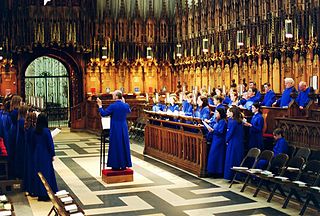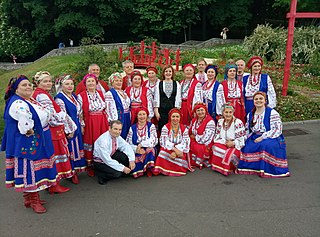Related Research Articles

A choir is a musical ensemble of singers. Choral music, in turn, is the music written specifically for such an ensemble to perform or in other words is the music performed by the ensemble. Choirs may perform music from the classical music repertoire, which spans from the medieval era to the present, or popular music repertoire. Most choirs are led by a conductor, who leads the performances with arm, hand, and facial gestures.
In music, solfège or solfeggio, also called sol-fa, solfa, solfeo, among many names, is a mnemonic used in teaching aural skills, pitch and sight-reading of Western music. Solfège is a form of solmization, though the two terms are sometimes used interchangeably.

A composer is a person who writes music. The term is especially used to indicate composers of Western classical music, or those who are composers by occupation. Many composers are, or were, also skilled performers of music.

Conducting is the art of directing a musical performance, such as an orchestral or choral concert. It has been defined as "the art of directing the simultaneous performance of several players or singers by the use of gesture." The primary duties of the conductor are to interpret the score in a way that reflects the specific indications in that score, set the tempo, ensure correct entries by ensemble members, and "shape" the phrasing where appropriate. Conductors communicate with their musicians primarily through hand gestures, usually with the aid of a baton, and may use other gestures or signals such as facial expression and eye contact. A conductor usually supplements their direction with verbal instructions to their musicians in rehearsal.

Shape notes are a musical notation designed to facilitate congregational and social singing. The notation, introduced in late 18th century England, became a popular teaching device in American singing schools. Shapes were added to the noteheads in written music to help singers find pitches within major and minor scales without the use of more complex information found in key signatures on the staff.

The Music of Wales, particularly singing, is a significant part of Welsh national identity, and the country is traditionally referred to as "the land of song".

Elijah, Op. 70, MWV A 25, is an oratorio by Felix Mendelssohn depicting events in the life of the Prophet Elijah as told in the books 1 Kings and 2 Kings of the Old Testament. It premiered on 26 August 1846.
A singing school is a school in which students are taught to sightread vocal music. Singing schools are a long-standing cultural institution in the Southern United States. While some singing schools are offered for credit, most are informal programs.

Anglican church music is music that is written for Christian worship in Anglican religious services, forming part of the liturgy. It mostly consists of pieces written to be sung by a church choir, which may sing a cappella or accompanied by an organ.
A Cymanfa Ganu is a Welsh festival of sacred hymns, sung with four-part harmony by a congregation, usually under the direction of a choral director.
The Kodály method, also referred to as the Kodály concept, is an approach to music education developed in Hungary during the mid-twentieth century by Zoltán Kodály. His philosophy of education served as inspiration for the method, which was then developed over a number of years by his associates. In 2016, the method was inscribed as a UNESCO Intangible Cultural Heritage.
A part song, part-song or partsong is a form of choral music that consists of a song to a secular or non-liturgical sacred text, written or arranged for several vocal parts. Part songs are commonly sung by an SATB choir, but sometimes for an all-male or all-female ensemble. Part songs are intended to be sung a cappella, that is without accompaniment, unless an instrumental accompaniment is particularly specified.

Ukrainian folk music includes a number of varieties of traditional, folkloric, folk-inspired popular music, and folk-inspired European classical music traditions.

A men's chorus or male voice choir (MVC), is a choir consisting of men who sing with either a tenor or bass voice, and whose music is typically arranged into high and low tenors, and high and low basses —and shortened to the letters TTBB. The term can also refer to a piece of music which is performed by such a choir.

Franz Xaver Witt was a Catholic priest, church musician, and composer. He was a leading figure in the Cecilian movement for the reform of Catholic church music in the second half of the 19th century.
Psalmist movement is a term that covers a period of mass musical education in Britain having its roots in the dissenting congregational church singing organisations of late 18th century in regional Scotland and Northern England, which, by the mid-19th century, was to become a vibrant metropolitan cultural institution, coinciding with radical developments in broader national schools policy, the latter owing much to the teaching methods used by the psalmist singing schools. It is sometimes also referred to as the 'choral revival'.
The Psalmody Movement is a general term often used to cover a period of mass musical education in Britain. It is sometimes also referred to as the "choral revival". It had its roots in the dissenting congregational church singing organisations of the late 18th century, in Scotland and Northern England. By the mid-19th century, it had become a metropolitan cultural institution. It coincided also with developments in national schools policy, which owed much to the teaching methods used by the psalmody singing schools.

Church music in Scotland includes all musical composition and performance of music in the context of Christian worship in Scotland, from the beginnings of Christianisation in the fifth century, to the present day. The sources for Scottish Medieval music are extremely limited due to factors including a turbulent political history, the destructive practices of the Scottish Reformation, the climate and the relatively late arrival of music printing. In the early Middle Ages, ecclesiastical music was dominated by monophonic plainchant, which led to the development of a distinct form of liturgical Celtic chant. It was superseded from the eleventh century by more complex Gregorian chant. In the High Middle Ages, the need for large numbers of singing priests to fulfill the obligations of church services led to the foundation of a system of song schools, to train boys as choristers and priests. From the thirteenth century, Scottish church music was increasingly influenced by continental developments. Monophony was replaced from the fourteenth century by the Ars Nova consisting of complex polyphony. Survivals of works from the first half of the sixteenth century indicate the quality and scope of music that was undertaken at the end of the Medieval period. The outstanding Scottish composer of the first half of the sixteenth century was Robert Carver, who produced complex polyphonic music.
Joseph Robinson was an Irish composer, baritone, conductor, and teacher.
Coros de clave were popular choral groups that emerged at the end of the 19th century in Havana and other Cuban cities. Their style was influenced by the orfeones which grew popular in northern Spain in the mid-19th century, and their popularization in the island was linked to the emancipation of African slaves in 1886. The common instrumentation of the coros featured a viola, claves, guitar, harp and jug bass.